Ying Tang
Quantum Flow Matching
Aug 17, 2025Abstract:Flow matching has rapidly become a dominant paradigm in classical generative modeling, offering an efficient way to interpolate between two complex distributions. We extend this idea to the quantum realm and introduce Quantum Flow Matching (QFM)-a fully quantum-circuit realization that offers efficient interpolation between two density matrices. QFM offers systematic preparation of density matrices and generation of samples for accurately estimating observables, and can be realized on a quantum computer without the need for costly circuit redesigns. We validate its versatility on a set of applications: (i) generating target states with prescribed magnetization and entanglement entropy, (ii) estimating nonequilibrium free-energy differences to test the quantum Jarzynski equality, and (iii) expediting the study on superdiffusion breakdown. These results position QFM as a unifying and promising framework for generative modeling across quantum systems.
MHAF-YOLO: Multi-Branch Heterogeneous Auxiliary Fusion YOLO for accurate object detection
Feb 07, 2025Abstract:Due to the effective multi-scale feature fusion capabilities of the Path Aggregation FPN (PAFPN), it has become a widely adopted component in YOLO-based detectors. However, PAFPN struggles to integrate high-level semantic cues with low-level spatial details, limiting its performance in real-world applications, especially with significant scale variations. In this paper, we propose MHAF-YOLO, a novel detection framework featuring a versatile neck design called the Multi-Branch Auxiliary FPN (MAFPN), which consists of two key modules: the Superficial Assisted Fusion (SAF) and Advanced Assisted Fusion (AAF). The SAF bridges the backbone and the neck by fusing shallow features, effectively transferring crucial low-level spatial information with high fidelity. Meanwhile, the AAF integrates multi-scale feature information at deeper neck layers, delivering richer gradient information to the output layer and further enhancing the model learning capacity. To complement MAFPN, we introduce the Global Heterogeneous Flexible Kernel Selection (GHFKS) mechanism and the Reparameterized Heterogeneous Multi-Scale (RepHMS) module to enhance feature fusion. RepHMS is globally integrated into the network, utilizing GHFKS to select larger convolutional kernels for various feature layers, expanding the vertical receptive field and capturing contextual information across spatial hierarchies. Locally, it optimizes convolution by processing both large and small kernels within the same layer, broadening the lateral receptive field and preserving crucial details for detecting smaller targets. The source code of this work is available at: https://github.com/yang0201/MHAF-YOLO.
DeepSeek-V3 Technical Report
Dec 27, 2024



Abstract:We present DeepSeek-V3, a strong Mixture-of-Experts (MoE) language model with 671B total parameters with 37B activated for each token. To achieve efficient inference and cost-effective training, DeepSeek-V3 adopts Multi-head Latent Attention (MLA) and DeepSeekMoE architectures, which were thoroughly validated in DeepSeek-V2. Furthermore, DeepSeek-V3 pioneers an auxiliary-loss-free strategy for load balancing and sets a multi-token prediction training objective for stronger performance. We pre-train DeepSeek-V3 on 14.8 trillion diverse and high-quality tokens, followed by Supervised Fine-Tuning and Reinforcement Learning stages to fully harness its capabilities. Comprehensive evaluations reveal that DeepSeek-V3 outperforms other open-source models and achieves performance comparable to leading closed-source models. Despite its excellent performance, DeepSeek-V3 requires only 2.788M H800 GPU hours for its full training. In addition, its training process is remarkably stable. Throughout the entire training process, we did not experience any irrecoverable loss spikes or perform any rollbacks. The model checkpoints are available at https://github.com/deepseek-ai/DeepSeek-V3.
EdgeOAR: Real-time Online Action Recognition On Edge Devices
Dec 02, 2024



Abstract:This paper addresses the challenges of Online Action Recognition (OAR), a framework that involves instantaneous analysis and classification of behaviors in video streams. OAR must operate under stringent latency constraints, making it an indispensable component for real-time feedback for edge computing. Existing methods, which typically rely on the processing of entire video clips, fall short in scenarios requiring immediate recognition. To address this, we designed EdgeOAR, a novel framework specifically designed for OAR on edge devices. EdgeOAR includes the Early Exit-oriented Task-specific Feature Enhancement Module (TFEM), which comprises lightweight submodules to optimize features in both temporal and spatial dimensions. We design an iterative training method to enable TFEM learning features from the beginning of the video. Additionally, EdgeOAR includes an Inverse Information Entropy (IIE) and Modality Consistency (MC)-driven fusion module to fuse features and make better exit decisions. This design overcomes the two main challenges: robust modeling of spatio-temporal action representations with limited initial frames in online video streams and balancing accuracy and efficiency on resource-constrained edge devices. Experiments show that on the UCF-101 dataset, our method EdgeOAR reduces latency by 99.23% and energy consumption by 99.28% compared to state-of-the-art (SOTA) method. And achieves an adequate accuracy on edge devices.
The Evolution and Future Perspectives of Artificial Intelligence Generated Content
Dec 02, 2024



Abstract:Artificial intelligence generated content (AIGC), a rapidly advancing technology, is transforming content creation across domains, such as text, images, audio, and video. Its growing potential has attracted more and more researchers and investors to explore and expand its possibilities. This review traces AIGC's evolution through four developmental milestones-ranging from early rule-based systems to modern transfer learning models-within a unified framework that highlights how each milestone contributes uniquely to content generation. In particular, the paper employs a common example across all milestones to illustrate the capabilities and limitations of methods within each phase, providing a consistent evaluation of AIGC methodologies and their development. Furthermore, this paper addresses critical challenges associated with AIGC and proposes actionable strategies to mitigate them. This study aims to guide researchers and practitioners in selecting and optimizing AIGC models to enhance the quality and efficiency of content creation across diverse domains.
Autogenic Language Embedding for Coherent Point Tracking
Jul 30, 2024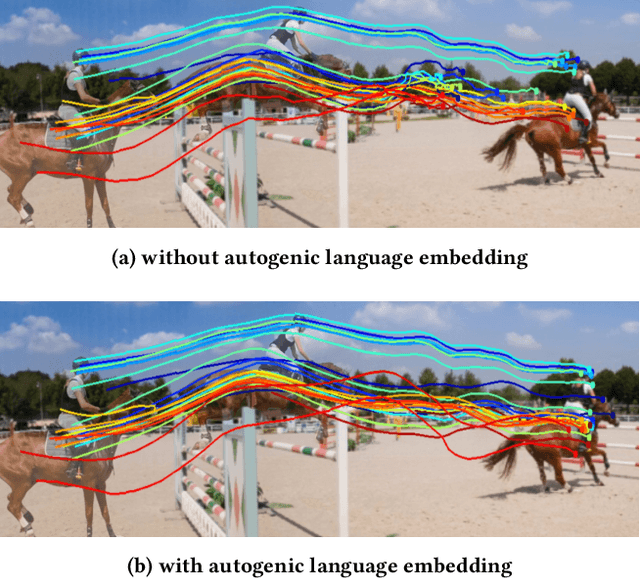

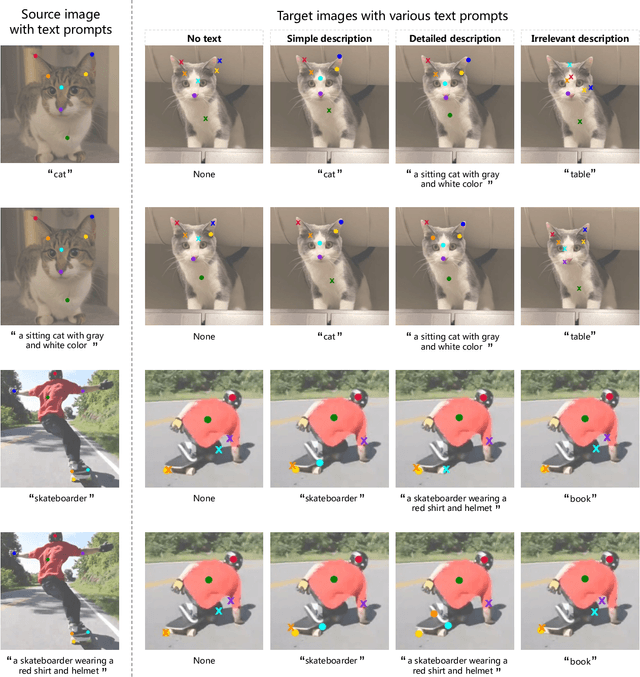

Abstract:Point tracking is a challenging task in computer vision, aiming to establish point-wise correspondence across long video sequences. Recent advancements have primarily focused on temporal modeling techniques to improve local feature similarity, often overlooking the valuable semantic consistency inherent in tracked points. In this paper, we introduce a novel approach leveraging language embeddings to enhance the coherence of frame-wise visual features related to the same object. Our proposed method, termed autogenic language embedding for visual feature enhancement, strengthens point correspondence in long-term sequences. Unlike existing visual-language schemes, our approach learns text embeddings from visual features through a dedicated mapping network, enabling seamless adaptation to various tracking tasks without explicit text annotations. Additionally, we introduce a consistency decoder that efficiently integrates text tokens into visual features with minimal computational overhead. Through enhanced visual consistency, our approach significantly improves tracking trajectories in lengthy videos with substantial appearance variations. Extensive experiments on widely-used tracking benchmarks demonstrate the superior performance of our method, showcasing notable enhancements compared to trackers relying solely on visual cues.
Ontology-driven Reinforcement Learning for Personalized Student Support
Jul 14, 2024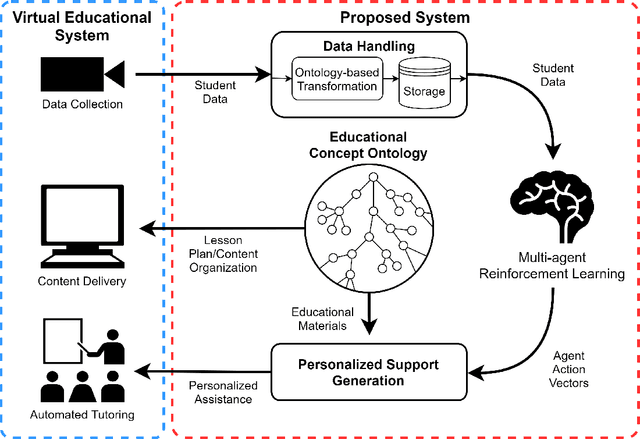
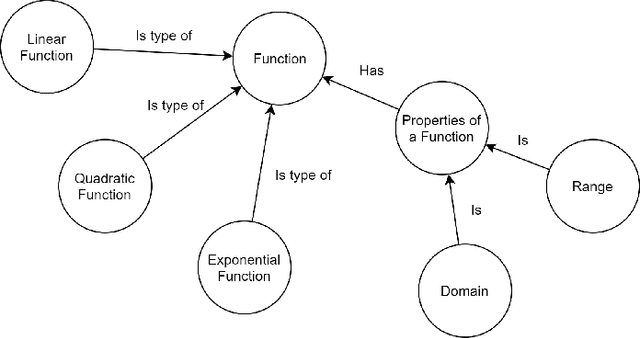
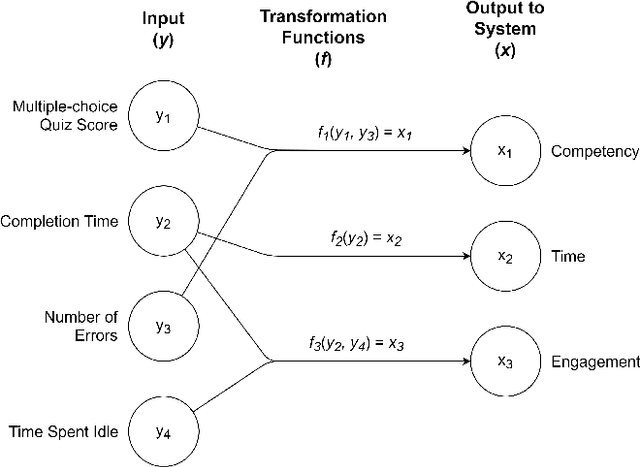
Abstract:In the search for more effective education, there is a widespread effort to develop better approaches to personalize student education. Unassisted, educators often do not have time or resources to personally support every student in a given classroom. Motivated by this issue, and by recent advancements in artificial intelligence, this paper presents a general-purpose framework for personalized student support, applicable to any virtual educational system such as a serious game or an intelligent tutoring system. To fit any educational situation, we apply ontologies for their semantic organization, combining them with data collection considerations and multi-agent reinforcement learning. The result is a modular system that can be adapted to any virtual educational software to provide useful personalized assistance to students.
Multi-Branch Auxiliary Fusion YOLO with Re-parameterization Heterogeneous Convolutional for accurate object detection
Jul 05, 2024



Abstract:Due to the effective performance of multi-scale feature fusion, Path Aggregation FPN (PAFPN) is widely employed in YOLO detectors. However, it cannot efficiently and adaptively integrate high-level semantic information with low-level spatial information simultaneously. We propose a new model named MAF-YOLO in this paper, which is a novel object detection framework with a versatile neck named Multi-Branch Auxiliary FPN (MAFPN). Within MAFPN, the Superficial Assisted Fusion (SAF) module is designed to combine the output of the backbone with the neck, preserving an optimal level of shallow information to facilitate subsequent learning. Meanwhile, the Advanced Assisted Fusion (AAF) module deeply embedded within the neck conveys a more diverse range of gradient information to the output layer. Furthermore, our proposed Re-parameterized Heterogeneous Efficient Layer Aggregation Network (RepHELAN) module ensures that both the overall model architecture and convolutional design embrace the utilization of heterogeneous large convolution kernels. Therefore, this guarantees the preservation of information related to small targets while simultaneously achieving the multi-scale receptive field. Finally, taking the nano version of MAF-YOLO for example, it can achieve 42.4% AP on COCO with only 3.76M learnable parameters and 10.51G FLOPs, and approximately outperforms YOLOv8n by about 5.1%. The source code of this work is available at: https://github.com/yang-0201/MAF-YOLO.
TIDE: Test Time Few Shot Object Detection
Nov 30, 2023Abstract:Few-shot object detection (FSOD) aims to extract semantic knowledge from limited object instances of novel categories within a target domain. Recent advances in FSOD focus on fine-tuning the base model based on a few objects via meta-learning or data augmentation. Despite their success, the majority of them are grounded with parametric readjustment to generalize on novel objects, which face considerable challenges in Industry 5.0, such as (i) a certain amount of fine-tuning time is required, and (ii) the parameters of the constructed model being unavailable due to the privilege protection, making the fine-tuning fail. Such constraints naturally limit its application in scenarios with real-time configuration requirements or within black-box settings. To tackle the challenges mentioned above, we formalize a novel FSOD task, referred to as Test TIme Few Shot DEtection (TIDE), where the model is un-tuned in the configuration procedure. To that end, we introduce an asymmetric architecture for learning a support-instance-guided dynamic category classifier. Further, a cross-attention module and a multi-scale resizer are provided to enhance the model performance. Experimental results on multiple few-shot object detection platforms reveal that the proposed TIDE significantly outperforms existing contemporary methods. The implementation codes are available at https://github.com/deku-0621/TIDE
Learning noise-induced transitions by multi-scaling reservoir computing
Sep 11, 2023Abstract:Noise is usually regarded as adversarial to extract the effective dynamics from time series, such that the conventional data-driven approaches usually aim at learning the dynamics by mitigating the noisy effect. However, noise can have a functional role of driving transitions between stable states underlying many natural and engineered stochastic dynamics. To capture such stochastic transitions from data, we find that leveraging a machine learning model, reservoir computing as a type of recurrent neural network, can learn noise-induced transitions. We develop a concise training protocol for tuning hyperparameters, with a focus on a pivotal hyperparameter controlling the time scale of the reservoir dynamics. The trained model generates accurate statistics of transition time and the number of transitions. The approach is applicable to a wide class of systems, including a bistable system under a double-well potential, with either white noise or colored noise. It is also aware of the asymmetry of the double-well potential, the rotational dynamics caused by non-detailed balance, and transitions in multi-stable systems. For the experimental data of protein folding, it learns the transition time between folded states, providing a possibility of predicting transition statistics from a small dataset. The results demonstrate the capability of machine-learning methods in capturing noise-induced phenomena.
 Add to Chrome
Add to Chrome Add to Firefox
Add to Firefox Add to Edge
Add to Edge